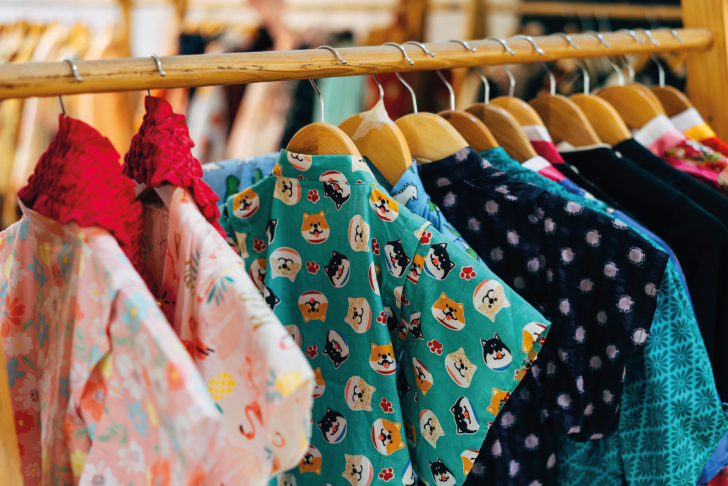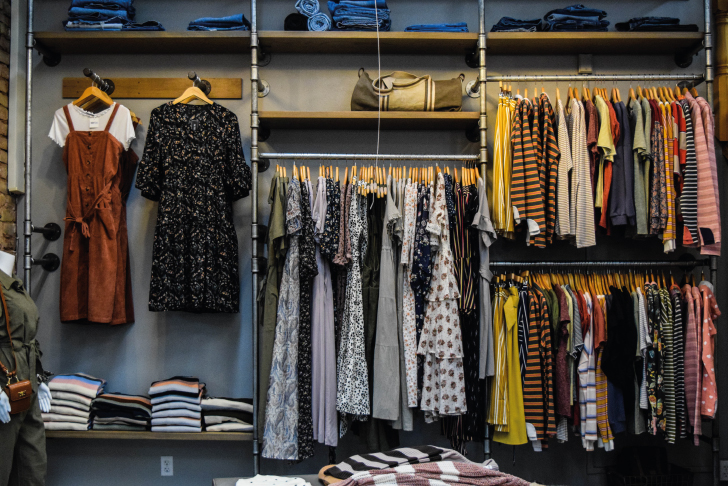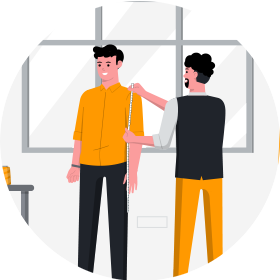Setting Up Your Clothing Line
In Australia, apparel is close to a $30 billion market, while global revenues reach over $1 trillion annually.
So, whether you plan to create a local store or a global sensation, there are many business opportunities in fashion. To take advantage of these, you must have a plan and understand how to set up your clothing line.
This post will cover everything from setting up your clothing line to manufacturing, marketing and more.
If you plan to create a clothing brand, you are likely passionate about design and fashion.
But there's more to starting a fashion line than interest in the industry alone. You'll need business and design skills, drive, and commitment to create a successful business.
The good news is you can learn everything from the internet or through formal courses.
Creating a Business Plan

Your business plan can be straightforward or as complex as you need.
A simple one-page roadmap may be enough if you want to bootstrap your new business. However, you'll need more details if you take on investors.
Here's what you should consider when writing a business plan:
- Finances: Note your start-up costs and your plan to pay for them. You can also mention sales projections, reinvestment plans and business goals.
- Market overview: Write down your assessment of your industry and niche. You can include ideal customer profiles, statistics, and competitive analyses.
- About section: An overview of what you aim to achieve, why you want to achieve it and how.
- Marketing: List your marketing methods and detail how you will execute them.
- Logistics: Add details about your suppliers, inventory management and shipping procedures.
- Products: List all the items that you'll be selling. Add details such as material composition, sizing, colours and what makes them unique.
Create a Rough Timeline For Your Clothing Business
There are many steps in starting your own business. That's why creating a plan with deadlines to track your progress is a good idea.
Your timeline doesn't have to be precise, but it should be realistic. Give yourself a time buffer at each stage so you're not rushing.
Here's how:
- Consider the tasks you need to complete, e.g., register your business, find suppliers, etc.
- Break larger projects into smaller tasks, e.g., register a business becomes: research how to register a business, gather your information, etc.
- Estimate the time you require for each task and add a buffer, e.g., 10% extra time.
Then you can turn your estimates into a simple timeline to determine what you should do next.
Registering Your Fashion Company

Before selling products, you'll need to register to receive an ABN identification number. You may also need an ACN depending on your chosen business structure.
To apply, head to the ABR website. You'll need to input details like email, business name, bank account and purpose.
You’ll also need to choose a business entity, for example:
- Sole trader (sole proprietorship)
- Partnership
- Proprietary limited company (Limited liability company)
You can complete this process yourself or use a tax agent.
Consider the Costs of Setting Up Your Clothing Line and Store
Before you set up your business, you must know the costs involved.
Here's what to consider:
Equipment
This total will vary depending on the size of your store so consider this a general guideline:
- Clothing racks: $150 x 10 = $1,500
- Mannequins: $200 x 3 = $600
- Display tables: $250 x 3 = $750
- Point-of-sale equipment: $1,200+ (includes computer)
- Point-of-sale software: $100 per month
- Shelving: $200 x 5 = $1,000
- Signage: $100
- Clothes steamer: $800
Total = $5,150
Find out more: Need funding? Check out our guide on small business grants.
Renting a shop
Rental costs will vary depending on your location, but to give you an idea:
- Australian department stores in large shopping centres average $225 per square metre per quarter.
- Large Format Retail rents average $622 in NSW and $210 in WA per square metre per quarter.
Buying a shop
Since you can't buy a store inside a large shopping centre, you'll need to look at neighbourhood retail property. On average, these properties will cost around $5,575 per square metre.
You'll also need to consider additional fees such as:
- Insurance
- Appraisal fees
- Attorney fees
- Lender fees and interest
Typically, buyers will pay between 2 to 5 per cent of the purchase price in closing fees.
Hiring employees
If you run a retail store, you'll only need a part-time assistant at the beginning, which costs about $20 - $25 per hour.
Once you start to grow, you can consider hiring full-time staff such as:
- Retail Store Manager $55k to $65k
- Retail Sales Assistant $50k to $60k
- Fashion Designer $60k to $80k
You can also outsource your design needs to freelancers on Fiverr and Upwork. These designers will often be budget-friendly since you can work with overseas freelancers.
Stock
Your stock costs will depend on several factors, e.g., how much you buy, your distribution method and type.
If you decide to go the wholesale route, WholeSale T-shirt sells stock for around $5 per piece, depending on quantity. So, if you start with four t-shirt types and 100 of each, your initial investment will be about $1,500.
If you choose other options like Print on Demand, you'll only need enough to cover each sale until the customer's payment clears.
Figure out your funding options
If you need funding for your fashion business, these are your options:
- Angel investors: These people invest early in the business and often become advisors. You'll likely need to provide equity as payment for the loan, so you'll need to value your business and its potential accurately.
- Crowdfunding: An excellent option if you don't want to spend too much upfront. You can presell your clothing on a website like Kickstarter and only commit to making them if there's enough demand.
- Government grants: The government provides many small business grants to help start your company. Some function as low-interest loans, while others aren't necessary to pay back. You can check out our Australian small business grant guide for information.
- Loans: Most people choose major banks or private lenders. But if you have no luck, you can also try peer-to-peer loans. You can learn more about these options in our business loan guide.
Pricing your products
Your product pricing needs to be profitable for your business and affordable for your target market.
Here's what to consider:
- Cost-per-unit: Consider both the variable and fixed costs involved in making a sale. Variable costs include shipping, packaging, and marketing. Fixed expenses include running costs such as loan repayments, rent and utilities.
- Competitor prices: While you don't need to price your products the same as your competitors, they shouldn't be wildly different. If your main competitors are moderately priced brands like Calvin Klein, success will be difficult with Gucci pricing.
Clothing regulations in Australia
Companies will likely follow regulations if you're buying or manufacturing clothes in Australia. However, importing stock from overseas will be different.
Major regulations to consider include:
- Children's clothing standards, i.e., clothing and product safety.
- Chemical concentrations in clothing.
- Labelling standards, i.e., materials, origin, etc.
You can find all mandatory and voluntary standards through the ACCC.
Clothing Design and Manufacturing Process

You have a few different options during the design and manufacturing stage:
1. Designing from scratch
If you choose this option, you'll need to deal with manufacturers, which leaves you two options:
- Local manufacturers: Buying local makes it easier to find high-quality stock as Australia has stringent regulations. Your cost per piece will be more expensive, but you won't have to deal with importing and its extra charges.
- Overseas manufacturers: The main benefits of this option are the lower prices and more options. However, certain countries lack regulations which can result in poor quality products—and human-rights issues, as you may have seen with Shein. You'll also have to navigate importing rules, taxes, and language barriers.
To receive an accurate quote, you'll need to create a technical pack or specification sheet that includes:
- A picture of your design with precise measurements
- The materials you want to us
- A sizing chart and ratios
- Your care label design
- The graphics you'd like to add
2. Wholesale customisation
Wholesalers are an excellent option if you can't afford a manufacturer's minimum order quantity.
These businesses typically stock plain garments in popular styles at lower prices than retail stores. You'll have less flexibility with the fit of the clothes, but you're free to add graphic designs.
You can add prints yourself or find a wholesaler that offers that service.
3. Direct-to-garment printing
Direct-to-garment printing is an easy way to customise plain clothing. It's a durable option and allows you to choose from many colours. It also allows you to use Print-on-demand (POD) services for fulfilment.
POD fulfilment lets you skip the upfront investment, improve cash flow, and only pay for stock when a customer places an order. Plus, these companies often ship straight to your customers, making it easier to run an eCommerce business.
But if you open a retail store, you can also place bulk orders, so you have stock for shoppers to browse.
Importing and exporting considerations
If you decide to import from overseas, you'll likely need to pay GST, customs duty and import processing fees.
These amounts will vary depending on the size of your shipments, so it may be worth using an agent to simplify the process. For more information, you can check out the ABF website.
The Australian government generally doesn't charge anything if you ship clothes overseas. However, you (or the buyer) may be subject to fees by the receiving country.
Marketing Your Clothing Line
Branding is vital if you want to compete in the fashion industry.
It shows customers who your brand is and what it stands for, making it easy for them to decide if they like you. A unique brand is also memorable, which helps you build a following.
Decide what makes your business unique and promote that through your marketing, brand design and customer interactions.
Here are a few ways to differentiate your brand:
- Origin story: Sharing your story helps customers connect with your brand. For example, Toms Shoes' origin story revolves around its founder witnessing poverty while travelling. He then created a footwear brand that donates shoes to needy children whenever someone buys from the company.
- Design: Design elements make it easy to identify a brand. For example, minimalist brands use mute shades like black, grey, and white. Typography and fonts also matter. Handwritten fonts seem approachable and informal, while sans-serif fonts promote simplicity.
- Products: Is there anything unique about your products? Make sure customers know these, as they're your main selling points.
Online vs offline marketing plan
Millions of Australians shop online each month, so having an online business presence is vital. Not only does an eCommerce store allow customers to shop when it's convenient, but it also increases your customer base significantly.
However, you shouldn't discount the power of a brick-and-mortar store. Some customers prefer in-store shopping, while others combine online checkouts and in-store pickups.
If possible, it's a good idea to offer both options so you can provide an ideal shopping experience for all your customers.
Here are some ways you can market your clothes in both situations:
1. Create a website
The easiest way to build your website is with a platform like Wix, BigCommerce, Shopify, etc. Shopify is an excellent eCommerce platform if you prefer simplicity, while Wix is better for customizability.
Building your own website is the cheapest option. Wix offers monthly plans ranging from $25 - $50 with integrated eCommerce capabilities and payment gateways. Other costs like your domain name and hosting are around $50 - $100 per year.
2. List items on an online marketplace
Fashion marketplaces have steady traffic streams, so they're a great option when selling online. While you'll make less profit per sale, having access to millions of customers will compensate for it.
Top Australian fashion marketplaces include:
But there are many others where you can list your clothes—both in Australia and overseas.
3. Stock your clothes at other stores
While breaking into an independent boutique is easier, getting your line into a national department store is the key to rapid success.
To land a section in either type of store, you should:
- Create a one-page information sheet that details your pricing and terms.
- Network with buying agents and boutique owners through LinkedIn to learn what they look for in a brand.
- Know and share your unique selling points.
You also have the option to recruit a professional product broker if you have the budget.
The most popular fashion-centric department stores are Myer and David Jones. But there are hundreds of boutique stores to choose from, like these independent stores in Melbourne.
4. Attend trade shows
Trade shows give you access to suppliers, customers, and potential business partners in one place. Trade shows give you access to suppliers, customers, and potential business partners in one place.
Options include:
5. Post on social media
Instagram and TikTok are great marketing platforms for clothing brands since they focus on visual media. Top brands like Shein reach millions of customers daily, and so can you if you're consistent.
Tips for growing your social profiles include:
- Work with influencers to promote your online sales and repurpose user-generated content.
- Create a regular posting schedule and stick to it. You can use a tool like Sprout Social to schedule and automatically post your updates.
- Interact with brands, boutiques, and potential customers, but make your comments meaningful, so they don't resemble spam.
Find out more: Need more advice on this sector? Read our sector-specific articles.
Conclusion

Buying an existing business can help you fast forward your journey.
You don't have to build from scratch or worry about whether your idea is good. Instead, you can buy a revenue-generating asset that's already running. Our business buying guide will show you how.
But if you want to create your own clothing line, remember that it takes time and effort to succeed. Some designs will be popular while others will fall flat, but it's all part of the journey. You can check out our clothing businesses for sale to discover what businesses may be of interest to you.
And now that you know how to start your clothing line, it's also a good idea to learn how to run your clothing business.
Whether you choose to buy or build your clothing business, we want to wish you luck on your entrepreneurial journey. If you need any support or guidance, feel free to contact us—we'd be happy to help.
